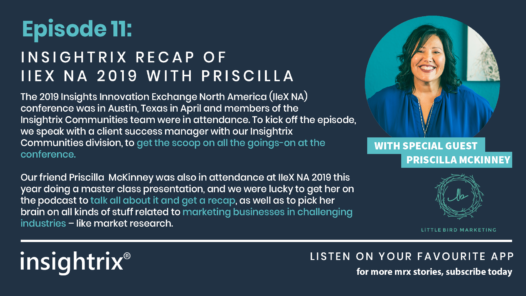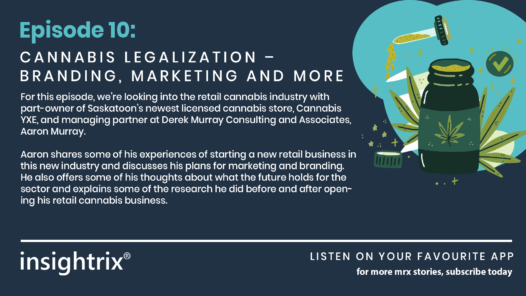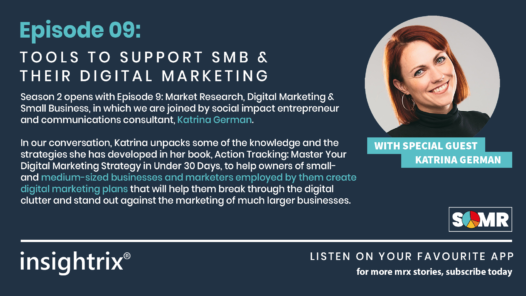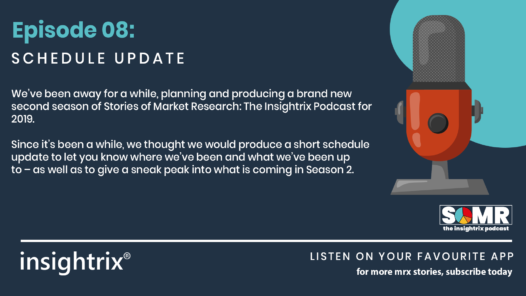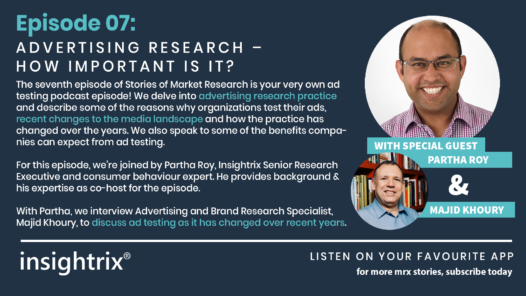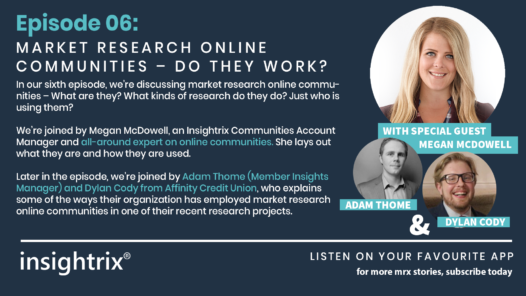In our inaugural episode of the podcast, we speak with Ellen Eastwood, independent research and insights consultant, instructor with the Marketing Research and Intelligence Association (MRIA) and research storyteller.
During the podcast, we chat about the shift that has occurred over the past few years in the way that market research agencies have chosen to report their data to clients and to the public. Rather than the data-dumping style of reporting common in the last few decades, more and more market researchers and their agencies have chosen to adopt a more client-friendly approach to their reports.
They have done this through developing reports that are more narrative in nature, telling the story of the data in ways that are actionable and understandable upon first reading rather than providing reports that leave clients with little more than charts and figures with a little perspective on their importance.
“What we’ve done is started shifting away from the data dump into a more strategic – almost like a professional services-type reporting style where things are a little bit more shorter and more professional – less dependent on numbers and more dependent on story.”
– Ellen Eastwood, Independent Research and Insights Consultant
If you’d like to learn more about the MRIA, check out their website.
Episode Transcript
[DUNCAN]
Reporting in market research has changed over the years.
Where once junior employees were relegated to dank and byzantine graphing departments that spat out endless reams of data – only to have it dumped uninterpreted on the laps of confused clients – market research reporting has evolved.
Now – market researchers often try to act as storytellers – working to guide their clients through the research data to discover the narrative that data holds.
Hello and welcome to the inaugural episode of Stories of Market Research: The Insightrix Podcast.
My name is Duncan McGregor – your podcast host and Marketing and Communications Coordinator at Insightrix Research in Saskatoon, Canada.
In this, our first episode – we are talking with Ellen Eastwood – an independent Research and Insights consultant – instructor with the Market Research and Intelligence Association – and research storyteller.
She joins us by phone from Toronto, Ontario – to discuss how insights reporting has changed over recent years.
In our conversation – we cover topics like why these changes have occurred in the first place, what the changes have meant to research firms, client-side engagement and much, much more – all coming up next on Stories of Market Research: The Insightrix Podcast. [OPENING THEME MUSIC]
DUNCAN: Alright, thank you very much Ellen for joining us all the way from Toronto and chatting with me. Welcome to our podcast.
ELLEN: Thank you so much.
DUNCAN: Our research department, and the rest of us honestly for that matter, we’re all really glad to get a chance to talk to you and pick your brain about a few things. So maybe, could we just jump right into it?
ELLEN: Absolutely.
DUNCAN: Excellent. Maybe you could give our audience an idea of who you are, some details about your background?
ELLEN: Sure. I’ve been in market research for about 17 years now, and I’ve spent a lot of time in the kind of small, boutique, generalist firms that are going the way of the dodo. Most of the generalist firms now are larger and the smaller, boutique firms tend to be more specialized. I came up in this industry back when you kind of owned a client relationship, not a certain type of research, so as a result, I’ve done all kinds of research. I’ve do qualitative, quantitative, brand, U&A, customer experience – you name that type of research. So, when I went freelance back in 2013, everyone – when you go freelance, they want to know what your specialty is. And the challenge for me is that I’m a generalist, so I was thinking to myself, what’s the real through-line that I could say is my specialty? And I’ve realized that the thing that I’ve always been passionate about in this industry is the storytelling aspect. And so, if you look at my LinkedIn, you’ll see that I’ve positioned myself as a research storyteller.
DUNCAN: Yeah, I’ve actually seen a lot of places, actually, describe your specialty as delivering strategic analysis that is relevant, digestible and easy to apply. Could you expand on that a little bit further?
ELLEN: Sure. I mean, the pretty simple thing is that I just don’t dump 200 slides on the client’s lap and say good luck with it. I decided before as the work version of the Da Vinci Code where you stick someone with 200 slides worth of bar charts and then say, you know, good luck with that. What I like to deliver is something that’s succinct and straightforward, and actually tells a story. In my mind, market research is not actually the answer. It plays a support role in business strategy, so I basically make sure that my clients are aware of the lay of the land so that they can make the business decisions they need to make.
DUNCAN: So, what other changes have you noticed in reporting format – like length, visuals, that kind of thing?
ELLEN: So, over the years, it’s interesting because I have to say, sadly, that there is a lot that hasn’t changed in our industry. There’s still a lot of those 200-slide bar charts reports out there. I recently saw a report that was say about 200 slides and it was a focus group report. And I thought, there’s absolutely no way that could be helpful to anybody.
DUNCAN: That’s just a huge data dump for somebody to take in all at once, right?
ELLEN: There you go. And I think that you’ve actually hit the phrase on the head with the idea of data dump. So, I mean, if anything, what we’ve done is started shifting away from the data dump into a more strategic – almost like a professional services-type reporting style where things are a little bit more shorter and more professional – less dependent on numbers and more dependent on story. I’ve also seen more of a willingness to go into identifying how target markets break out, short of having like a really formalized presentation. Something where we are going – you know, we’re seeing a real difference between these two or three groups based on, say, their lifestyle or their life stage or their attitudes and here are those differences that we’re seeing. It’s that idea that the market is not homogenous. That there are a lot of different segments out there and I think that market research has started to be, or has not started to be but is moving along that evolution of recognizing that more and helping to identify that for their clients.
DUNCAN: Yeah, and actually giving people actionable reports that you can give to people, right?
ELLEN: Yeah, absolutely.
DUNCAN: So, do you think that’s actually one of the reasons that these changes have occurred – the actionability concerns?
ELLEN: I think that’s part of it. I mean, I think there’s been – there’s a lot of industries that are related to market research that have started to siphon off some of what has traditionally been market research’s role. I mean, if you think about database analysis and professional services firms, there’s a lot of people out there doing – social media monitoring – there’s a lot of people doing things that are related to what we do. And for a while, people were feeling very threatened of what and where does market research have role? So, I think that a lot of us stepped up to that plate and said, OK, I think we need to become more actionable, shorter, more professional. And the other thing to remember, too, was that we don’t have the same attention span we used to have. You know, with the advent of how we consume media now, people don’t have the time for 100 or 200 slides. They want the story in a much shorter time, and I think market research has had to recognize that to compete.
DUNCAN: More along the lines of delivering key takeaways, as opposed to massive dumps of graphs and data and numbers.
ELLEN: Right.
DUNCAN: Is budgets a concern, as well? Do you think that is one of the reasons these things have happened, as well?
ELLEN: There could definitely be some of that. I’ve been in this industry long enough that I’ve had about half of my career before the economic decline and half of it after. And even though, of course, we have recovered from that, there still seems to be more budget sensitivity than there ever used to be. People are looking for ways to do things more economically, but people are still willing to take chances. I know at MRIA, a few years ago, there was a panel, and it was a client-side panel, and the main takeaway that I got from that was people saying, “Hey supply-side researchers. Help me convince my internal client that doing new and different types of research is important.” So, that’s something that I took away from that. Really, we have to be their partners in creating this new climate in market research. That’s something that we definitely get into in the course that I teach, The Essentials of Market Research. First of all, the client side, but also the supply side and being a partner in that way.
DUNCAN: Well, how can client-side researchers engage and vendors provide the most insightful results possible?
ELLEN: Well, you know, the thing, the biggest thing I have for – I actually did a bit of a TED Talk on the client role in research storytelling because I think there’s this general belief that clients don’t have to do much. Right? But if you look at the way most market research briefings happen, they tend to be very short and lacking in detail. They are often one-dimensional. If you compare it to an ad agency briefing, and the kind of multi-faceted – and I mean, they’ll go through the history of the company and the goals and the mission and the brand architecture, and here’s the profile of our consumers and etc. and so forth – and I always sit there and I’m thinking, “Why don’t we get the same kind of briefing to market research?” And there’s a couple of things happening there. First of all, I actually spent a couple of years client-side and realized how tough it is to get a good briefing from your internal clients, but also that we don’t really spend a lot of time on briefing skills and just how important that is. To my mind, there are two facets of storytelling that are critical to telling a good research story, and one of them is the briefing. People are always surprised when I say that because they don’t think it’s important as it is. But if you don’t have that foundation, it’s impossible to build a good research story.
DUNCAN: Going back to just research reporting in general, have you noticed any changes in programs used to do that?
ELLEN: I’m not so much in that area. There’s probably people who could do better than me, but one thing I’ve noticed is really taking some precedence. I think it’s doing a great job – and this is something I got immersed in at the last MRIA conference – is role of video in the kind of qualitative research that we do. And the fact that when you’re working in video, and the fact now that we all have such easy access to images and video from our phones, you can capture things in the situation as they’re happening that market research really struggles to get any other way. So that’s one thing that I’m really happy to see is taking a leading role and seems to be sort of emerging.
DUNCAN: So, that’s a lot of changes over the last little while, right?
ELLEN: There are. And I have to say that there a lot of people who are not making these changes. It’s taking awhile to get these changes going. I not trying to suggest that in the past five years, all research reports have been changed, but there are a lot of changes going on out there.
DUNCAN: I mean, what’s that mean to market research firms? Like skill sets for looking for new hires – what should we market researchers be looking for?
ELLEN: So, one thing – I mean, that’s a really interesting question. One of the things that I think a lot of market research firms don’t do is take into consideration the importance of intrinsic motivation – the idea of wanting to have people in your firm who are really interested in human behaviour. The real motivation to Gray’s analysis is if you are really interested in why people think what they think, say what they say and do what they do – and why sometimes what they say and what they do is different.
DUNCAN: You bet.
ELLEN: And that’s where video can be a real help too. But, you know, it’s interesting because I – this is many years ago now – but I interviewed at an organization and they did not hire me because they deemed my SPSS skills as not up to snuff. And I thought, that’s so, there’s no forward thinking in that because you can teach SPSS skills very easily. It is far harder to teach people to care about people, and that’s what makes a good researcher. It’s someone who’s interested in the – now, why would you buy that or why wouldn’t you buy that or what are the barriers to doing that. But I think the idea of moving away from the actual hard skills that someone has that you could easily teach in-house, and thinking about what are the soft skills? Those skills are so much more difficult to teach.
DUNCAN: So, if you’re looking to adapt, say, your research staff to this new style of reporting, what advice do you have adapting them to this style of reporting they’re not used to?
ELLEN: What I find is interesting is that it actually doesn’t take a lot of work with people to get people to kind of adapt to a different style because it is so much more interesting to actually be looking for data in the manner of pretending you’re a private detective almost, than it is to be focused on slapping down graphs and being so concerned with formatting. And so, people will respond when you actually bring them into it and say I think I understand why. And I find that if you actually do a little bit of work, if you kind of let your more junior employees do a bit of shadowing with you, then they could learn the true skills they really need to learn, which is one, that idea of how do we analyze data so that we can tell as story and B, how do we communicate it in a really simple, straightforward manner? That’s one thing that I’ve worked with a lot with junior employees is let’s just work on how we’re communicating this. And I have a few very simple principles for doing that and it doesn’t take most educated people more than one report or so to kind of get that style and understand it and work with it. But it’s just a bit of working with people.
DUNCAN: So, once you’ve got your staff in order, do you still find that there are still those clients who still want to see every number, full distributions to each question, even though they’re not very meaningful?
ELLEN: Oh, almost every client.
DUNCAN: Really?
ELLEN: And it’s not so much that they necessarily want to see it. They want the insurance. Right? They want to know that if someone comes up to me and asks X, I have the answer. So, what I propose in my course is to really change up the way we present so that you have a main body report presentation, and then you have an appendix. And the appendix is everything that’s not actually adding to the story. But then they have it there, so they feel comfortable but you also have a main body story.
DUNCAN: So, if they want the reports turned around more quickly, though, how would you balance the speed and the quality of that reporting then?
ELLEN: It can be a struggle. One of the things that I tell people is that because we do hear that a lot, right? We have to be faster. But the thing is that strategic analysis – you can’t run it through a program and get it. That is a human ability that takes time. You actually have to know what the data says before you can actually create a story with it. So, it does take time and for me, personally, I mean I am an independent so my response to that is that I only take so much work at a time because I can only manage so much work at a time. It would be up to firms to figure out how it is they do that. I mean, there are some ways to simplify that. Some of the things that we don’t really think about is taking a little time with our tab specs if you’re looking at quantitative data, and setting it up that you can actually see comparisons very simply and easily so that you don’t have to be searching and sifting. I like to – I think a lot of people don’t really look at the kind of banners that they could be using. If you look at attitudinal as a banner, or behaviour as a banner, then you can very quickly compare people who are doing things vs. not. In all of these different ways, but if you don’t think of that, then you’re going to do a lot of sifting and finding, right? Some of it has to do with being proactive.
DUNCAN: Excellent. So, this has all been super, super handy – I’m learning a lot from you today and I really appreciate it.
ELLEN: Thanks.
DUNCAN: You’ve got an event coming up here – here on the second of November in Regina.
ELLEN: That’s right, yeah.
DUNCAN: How can people – can you tell us a little bit about it?
ELLEN: So, this is through the MRIA, and I’m teaching my course, “The Essentials of Research Storytelling”. So, it’s a one-day course, and it goes through all of the various phases of research from the briefing right on through the presentation and how you embed good storytelling into all of the different phases of the research. Yeah, so it’s very simple to take a look at what it is and to sign up, and to do that, you just simply go to the MRIA website.
DUNCAN: OK.
ELLEN: mria/arim or something like that…
DUNCAN: There it is – www.mria-arim.ca. Or if you just want to Google it, just check out MRIA events and it will bring you right up there.
ELLEN: That’s right. I think even if you Google MRIA storytelling, you’ll probably come right to the page.
DUNCAN: Excellent. Well, I really want to encourage all of our listeners to go check it out.
ELLEN: Thank you very much. And I’m very looking forward to coming to do it in Regina. This will be the fourth time I’ve taught it, and all the others have been here in Toronto, so I’m really looking forward to taking it out on the road. And I’ve had great response when I posted it on LinkedIn – a bunch of different people saying we can’t wait to come!
DUNCAN: Well, hopefully the weather holds out for you.
ELLEN: Yeah, I hope so too.
DUNCAN: Excellent. Well, thanks again for agreeing to be on our show and we hope to see you again sometime.
ELLEN: Thank you so much. It was great talking with you Duncan.
[INTERSTITIAL MUSIC]DUNCAN: And there you have it.
We would like to thank Ellen Eastwood for appearing on our podcast and hope you’ll join her in Regina on the second of November for her “Essentials of Research Storytelling” presentation. Go to www.mria-arim.ca events to find out more.
I really enjoyed having a chance to talk with her – our interview where she describes her approach to reporting as storytelling, I hope will inform future episodes as we seek to explore the narratives, in both client and supply side, of market research.
We also want to thank you for joining us for our inaugural podcast. We’ll be back soon bringing you more interviews, insights and more on Stories of Market Research: The Insightrix Podcast.

